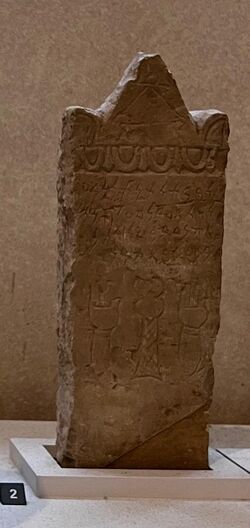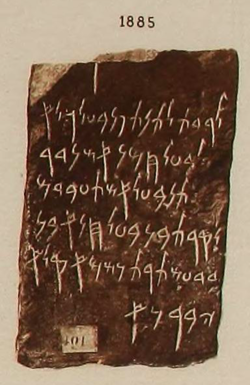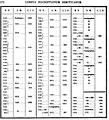Social:Pricot de Sainte-Marie steles
The Pricot de Sainte-Marie steles are more than 2,000 Punic funerary steles found in Carthage (modern Tunisia) near the ancient forum by French diplomat Jean-Baptiste Evariste Charles Pricot de Sainte-Marie in the 1870s. The find was dramatic both in the scale—the largest single discovery of Canaanite and Aramaic inscriptions—and also due to the finds almost being lost in the sinking of the French ironclad Magenta at Toulon.
The steles were found in their secondary location, having been re-used as building material for a wall in a structure erected after the city had been destroyed by the Romans.
The steles provide evidence of Carthaginian religion prior to the Roman occupation.
Pricot de Sainte-Marie obtained financial support from the French Académie des Inscriptions et Belles-Lettres to create a complication for publication in the Corpus Inscriptionum Semiticarum.[1][2] He took stampings of all the 2,170 steles he excavated, and had sent these to France prior to the sinking of the Magenta. They were later compiled and published in the Corpus Inscriptionum Semiticarum.[1]
After the sinking of the Magenta, a large number of the steles were recovered. They now reside at the Bibliothèque nationale de France and the Louvre.[1]
Recovery
Around 1,500 of the steles were recovered shortly after the sinking.
On 19 April 1994, the French Groupe de Recherche en Archéologie Navale led by Max Guérout, located the Magenta 50 feet below the surface, under four feet of sediment. The expedition had been catalyzed in 1992 by historian Serge Lancel and an amateur French archaeologist, Jean-Pierre Laporte. Guérout's team carried out 843 dives between 1994 and 1998, recovering 115 steles and fragments from the wreckage. Guérout estimated in 1999 that nearly 400 more steles may remain in the wreck.[3][4]
Examples of inscriptions
Text KAI 86 (= CIS I 264 = KI[5] 76) reads:[6][7]
KAI 87 (= CIS I 221 = KI 80). Ḥōt-’Ilot, the woman who ordered this stele, belonged to Carthage's elite: both her father and grandfather were head of state in Carthage (suffes):[6][7]
KAI 88 (= CIS I 1885 = KI 83):[6][7]
The proper names in those inscriptions are common ones. Their meanings are usually evident: ’Abdmilkot ("servant of the Queen"), Astartyaton ("Astarte has given"), Ḥōt-’Ilot ("’Ilot is [my] sister"), Hanno and Baalhanno ("he/Baal has shown him favor"), ‘Az-Milk ("Strong is [the] King"), Mattanbal ("gift of Baal"), and Bodastart ("in the service of Astarte").[7]
Concordance
Summary
In all, Pricot de Sainte-Marie documented 2,576 Carthaginian tombstones:
- 184 in private collections (see below)[1]
- 19 excavated 1874-75 sent to the Louvre[1]
- 2170 excavated 1874-75, stampings sent to the Bibliotheque Nationale[1]
- 203 further steles sent in 1878[8]
Private collections
Pricot de Sainte-Marie documented 184 steles in private collections:[1]
| Collections | Khaznadar (Palais de la Manouba) | Engley | Tulin de la Tunisie | Gouvet | Fenner | Abbe Bourgade | Rubichon | Chevarrier | Lunel | Bottary | Weber | De Touzon (Garden de la Chapelle Saint-Louis) | Total |
|---|---|---|---|---|---|---|---|---|---|---|---|---|---|
| Number of inscriptions | 124 | 5 | 4 | 2 | 9 | 14 | 2 | 1 | 2 | 1 | 2 | 18 | 184 |
2170 inscription stampings sent to the AIBL
Pricot de Sainte-Marie had taken stampings of all the steles he excavated, and had sent these to France prior to the sinking of the Magenta. They were later compiled and published in the Corpus Inscriptionum Semiticarum.[1]
| Dates inscriptions received by Académie des Inscriptions et Belles-Lettres | Comptes rendus des séances de l'Académie des Inscriptions et Belles-Lettres | Inscription number |
|---|---|---|
| 6 Nov 1874 | 1874, p. 314. | 1 to 34 |
| (20 Nov)? | 35 to 54 | |
| (27 Nov)? | 55 to 100 | |
| 4 Dec 1874 | 1874, p. 315. | 101 to 150 |
| 11 Dec 1874 | 1874, p. 316. | 151 to 200 |
| 18 Dec 1874 | 1874, p. 317-318. | 151 to 200 |
| 18 Dec 1874 | 201 to 300 | |
| 8 Jan 1875 | 1874, p. 2. | 301 to 350 |
| 22 Jan 1875 | 1875, p. 4. | 351 to 500 |
| 29 Jan 1875 | 1875, p. 5. | 501 to 600 |
| 29 Jan 1875 | 601 to 700 | |
| 5 Feb 1875 | 1875, p. 6. | 701 to 800 |
| 12 Feb 1875 | 1875, p. 7. | 801 to 901 |
| 19 Feb 1875 | 1875, p. 8. | 902 to 950 |
| 12 Mar 1875 | 1875, p. 11. | 951 to 1000 |
| (19 ou 26 Mar 1875) ? | 1001 to 1100 | |
| 2 Apr 1875 | 1875, p. 95. | 1101 to 1200 |
| 2 Apr 1875 | 1201 to 1300 | |
| 23 Apr 1875 | 1875, p. 98. | 1301 to 1500 |
| 30 Apr 1875 | 1875, p. 99. | 1501 to 1600 |
| 21 May 1875 | 1875, p. 103 | 1601 to 1900 |
| 4 Jun 1875 | 1875, p. 107. | 1901 to 2000 |
| 13 Aug 1875 | 1875, p. 195. | 2001 to 2082 |
| 12 Nov 1875 | 1875, p. 292. | 2083 to 2133 |
| 10 Dec 1875 | 1875, p. 297. | 2134 to 2147 |
| (17-24 Dec 1875) ? | 2148 to 2152 | |
| 14 Jan 1876 | 1876, p. 5. | 2153 to 2170 |
CIS
Later concordances
| Image | Discovered | Date | Location Found | Current Location | Concordance | ||||||
|---|---|---|---|---|---|---|---|---|---|---|---|
| KAI | CIS / RÉS | NE | KI | NSI | TSSI | Ref. | |||||
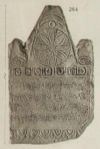
|
1874 | Carthage | 86 | I 264 | 76 | ||||||

|
Carthage | 87 | I 221 | 80 | |||||||
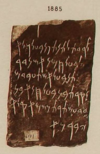
|
Carthage | 88 | I 1885 | 83 | |||||||
Bibliography
- de Sainte-Marie, J.B.E.C.P. (1876) (in fr). Les ruines de Carthage. Aux Bureaux de l'Explorateur. https://books.google.com/books?id=5YUOAAAAQAAJ. Retrieved 2022-10-05.
- de Sainte-Marie, É.C.P. (1884) (in fr). Mission à Carthage. E. Leroux. https://books.google.com/books?id=Dst7xQEACAAJ. Retrieved 2022-10-05.
- Laporte Jean-Pierre. Carthage: les stèles Sainte-Marie. In: Bulletin de la Société Nationale des Antiquaires de France, 1999, 2002. pp. 133-146. DOI: 10.3406/bsnaf.2002.10363
- LAPORTE, Jean-Pierre (2017-04-10). "Les Pricot de Sainte-Marie, père et fils, et l'archéologie de la Tunisie et de Carthage" (in fr). https://www.academia.edu/32359592.
- Lancel Serge. La fouille de l'épave du Magenta et le sauvetage de sa cargaison archéologique. In: Comptes rendus des séances de l'Académie des Inscriptions et Belles-Lettres, 139ᵉ année, N. 3, 1995. pp. 813-816. DOI: 10.3406/crai.1995.15521
- Berger, Philippe (1876). "Lettre à M. Fr. Lenormant" (in fr). NN. doi:10.11588/DIGLIT.25049.46. https://digi.ub.uni-heidelberg.de/diglit/gazette_archeologique1876/0122. Retrieved 2022-10-05.
- Lenormant, F. (1876). "Quelques observations sur symboles religieux des stèles puniques, [2"] (in fr). NN. doi:10.11588/DIGLIT.25049.56. https://digi.ub.uni-heidelberg.de/diglit/gazette_archeologique1876/0154. Retrieved 2022-10-05.
- Berger, Philippe (1877). "Lettre à M. Fr. Lenormant sur les représentations figurées de stèles puniques de la Bibliothèque Nationale, [1"] (in fr). NN. doi:10.11588/DIGLIT.25600.8. https://digi.ub.uni-heidelberg.de/diglit/gazette_archeologique1877/0030. Retrieved 2022-10-05.
References
- ↑ 1.0 1.1 1.2 1.3 1.4 1.5 1.6 1.7 LAPORTE, Jean-Pierre (2017-04-10). "Les Pricot de Sainte-Marie, père et fils, et l'archéologie de la Tunisie et de Carthage" (in fr). https://www.academia.edu/32359592.
- ↑ Renan's description in the CIS can be found at: Pars 1, Tomus 1: Fasc. 2 (p. 274-286), as well as Pars 1, Tomus 2: Fasc. 1 (p. 39)
- ↑ Harrington, Spencer P.M.. "Sunken Frigate Yields Carthaginian Artifacts". https://archive.archaeology.org/9907/newsbriefs/stelae.html.
- ↑ Audran, Gwendal (2022-05-18). "Découverte sous-marine avec le Nouveau Balaguier" (in fr). https://www.la-seyne.fr/decouverte-sous-marine-avec-le-nouveau-balaguier/.
- ↑ Lidzbarski, Mark (1907). Kanaanäische Inschriften (moabitisch, althebräisch, phönizisch, punisch). Giessen: Töpelmann. https://archive.org/details/kanaanischeinsc00lidzgoog/page/n5/mode/2up. Retrieved 27 November 2022. (Internet Archive)
- ↑ 6.0 6.1 6.2 Donner, Herbert; Rölig, Wolfgang (2002). Kanaanäische und aramäische Inschriften (5 ed.). Wiesbaden: Harrassowitz. pp. I, 21-22.
- ↑ 7.0 7.1 7.2 7.3 Krahmalkov, Charles R. (2000). Phoenician-Punic Dictionary. Leuven: Peeters / Departement Oosterse Studies. ISBN 90-429-0770-3.
- ↑ CRAI, 1878, p. 72 (séance du 3 mai 1878)
